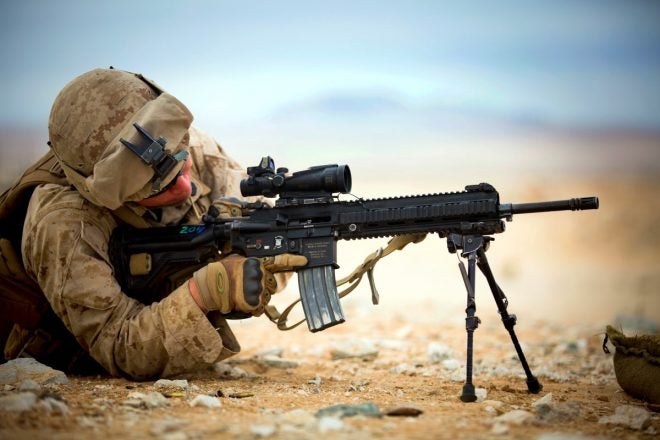In recent testimony to Congress, USMC leadership Lieutenant General Robert Walsh and Brigadier General Joseph Shrader officially acknowledged that the USMC’s M27 Infantry Automatic Rifle, made by Heckler & Koch, encounters durability issues when used with the US Army’s new M855A1 Enhanced Performance Round. The testimony is transcribed below:
Senator Rounds: During the – uh, either for General Walsh or Mr. Garner – during the full committee as well as the Airland Subcommittee testimony Army leadership and outside experts have cast doubt on the ability of the 5.56 rounds ability to penetrate modern composite body armor that is proliferating at an alarming rate. We’re concerned that Marine Infantry units could find the standard issue M4A1 ineffective, which, naturally, we would consider to be wholly unacceptable. How closely is the Marine Corps working with the Army in terms of fielding a new round that can penetrate enemy body armor and is there a strategy in place to accomplish this and if so please provide an update.
Lt. Gen. Walsh: We are, we’ve been after this for quite a while with the Army trying to – and Congress has pushed this direction to, to find a common round with the Army and just as you said we’re seeing more body armor wherever Marines and soldiers are deployed. More of it, and better quality, or better capability. So, the rounds that we currently have are M855 rounds, we have been in the process of looking at a SOCOM round, the [Mk.] 318A1, along with the M855A1 that the Army is using. We’ve been testing with them now for well over a year, trying to figure out the best round to go with. Indications are that we’re trying to go in the direction that the Army is – in fact right now our Marines that are deployed into Afghanistan with our weapons are using the Army round. So, there’s a lot of good reason to have commonality. The good news with that round, and with both rounds actually, much more capable and specifically the Army 855A1 much better at penetrating armor and along with personal armor protection. So, that’s a good reason to go with that, we have to work through a lot of things with our own weapons. The M4, our M27s, our IAR – Infantry Advanced Weapon (sic) – and along with our M16s. We’re working through some of the reliability things we’re learning in testing, but we’l make some adjustments with that and in the end I think our Marines will have a much better capability when we’re done with it.
Senator Rounds: So, you believe you’re moving in the right direction, with regards to the new-
Lt. Gen. Walsh: I do sir, and not only that, we’re looking with the Army at another weapon that would give us increased capability for our Marines to include a higher caliber weapon. And if you don’t mind, I’d like to let General Shrader, who knows a bit more about the testing of the 5.56 if he has time for that.
Brig. Gen. Shrader: So, sir, General Walsh is referring to the testing that we’ve been doing with the Army on the EPR round, which is their advanced round, which is the M855A1 round. That’s the one we’ve heard a lot about the Marine Corps and the Army having working toward. The testing that we’re doing is that round has had some durability – it causes some durability issues for our new Infantry Automatic Rifle that we fielded, the M27. The testing will be complete by July of this year, and along with performance and specifically stopping power, effect on the durability of that weapons system, the ancillary equipment like the Rifle Combat Optic – it has a flatter trajectory than the round we currently have – and also training facilities. That round requires a larger surface danger area that we have to take into account for our ranges. So those four areas are what we’re looking at for testing to inform us how we’ll go forward.
[emphasis mine]
The M27 was adopted by the Marine Corps in the 2010 as a replacement for the problematic belt-fed M249 Squad Automatic Weapon then in use. In that same year, the M855A1 was adopted by the US Army after several years of development, replacing the former M855 round used by both the Army and Marine Corps. However, Marine Corps testing showed some initial problems with the new round, especially in their M27 IARs. The round produced higher chamber pressure than the previous M855, and its exposed steel tip caused damage over time to the feedways of existing weapons, especially the tighter forcing cones of M27s. The higher gas port pressure also caused early unlocking which put additional stress on M27 bolts and shortened their lifespan. Over the next seven years, the Army incrementally improved the round in part to improve compatiblity with Marine Corps weapons. However, the M27/M855A1 combination remains a sub-optimal one, and an obstacle to the USMC’s acceptance of the Army round.
 Your Privacy Choices
Your Privacy Choices
